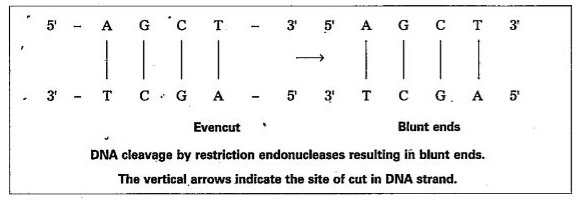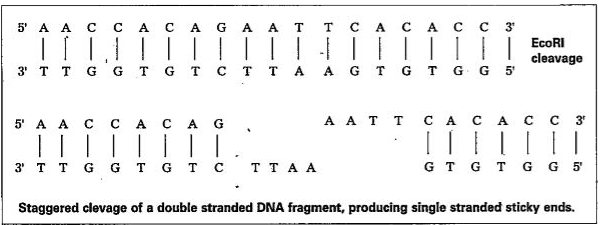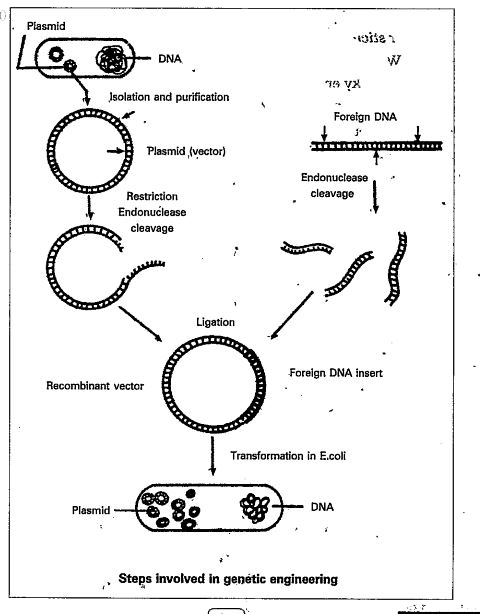The important methods in recombinant DNA technology are performed through genetic engineering. They are : i) Isolation of a desired gene, ii) Insertion of isolated gene into a suitable vector, iii) Introduction of recombinant vector into a host and iv) Selection of the transformed host cells.
I) Isolation of a desired gene : 1) The desired gene is isolated from the donor cell. Normally bacteria are the source of desired genes. 2) The cell walls of bacteria are degraded with the help of enzymes. 3) The cell membranes are lysed with the help of detergents. 4) By treating the cellular constituents with phenols and suitable nucleases and by subjecting to gradient centrifugation, pure DNA is isolated. 5) The purified DNA is cut into a number of fragments by restriction endonucleases. 6) The restriction enzymes cleave DNA molecules in two ways.
i) In one way they cut both strands of DNA at exactly opposite points to each other. This results in DNA fragments with blunt ends or flush ends, where two strands end at the same point. Such cut is generally termed as even cut.

ii) But commonly, most enzymes cut the two strands of DNA double helix at different locations. Such a cleavage is generally termed as staggered cut. This generates protruding ends i.e., one strand of DNA double helix extends some bases beyond the other. Since the target site is palindromic in nature, the protruding ends generated by such a cleavage have complimentary base sequence. As a result, they readily pair with each other and such ends are called cohesive or sticky ends. This stickyness of the ends facilitates the action of the enzyme DNA ligase. When cut by the same restriction enzyme, the resultant DNA fragments have the same kind of sticky ends. and these can be joined together readily by using DNA ligases. E.g.: The restriction enzyme E CORI.
E - The first letter, represents the name of genus Escherichia.
Co - The next two letters, represent the species Escherichia coli. The letter R is derived from the name of strain.
Roman numbers following the names indicate the order in which the enzymes were isolated from the strain of bacteria.
This enzyme specifically recognises GAA sites on the DNA and cuts if between G and `A(GdarrA)`

II) Insertion of isolated gene into a suitable vector : 1) The selected fragments of DNA are inserted into a suitable vector to produce a large number of copies of genes. This is called gene cloning. 2) There are two major types of vectors, namely plasmids and bacteriophages. 3) Among the two types, plasmids are the ideal cloning vectors. 4) To isolate a plasmid, the Bacterial cell is treated with EDTA (Ethylene diamine tetra acetic acid) along with lysozyme enzyme to digest the cell wall. 5) Then the bacterial cell is subjected to centrifugation in sodium lauryl sulphate to separate the plasmid. 6) The plasmid DNA is cut with the help of restriction endonuclease. 7) The circular plasmid is converted into a linear molecule having sticky ends. 8) The two sticky ends of linear plasmid are joined to the ends of desired gene by DNA ligase. 9) The plasmid containing foreign DNA segments is called recombinant DNA (r DNA) or Chimeric DNA.
III) Introduction of recombinant vector into a suitable host : 1) The r DNA molecule is introduced into suitable bacterial host cell by transformation. 2) The cell containing r DNA is called transformed cell. 3) Bacterial cell walls are not permeable to recombinant vectors, but keeping in dil. Calcium chloride renders the bacterial cell wall permeable to recombinant vectors. 4) The r DNA replicates with in the host cell. 5) The transformed cell grows on the culture medium. Each daughter cell contains r DNA.
IV) Sélection of transformed host cells : 1) Selection of transformed cells depends on the nature of gene which is cloned. 2) It can be done in two ways. The are:
a) Without using probes,
b) By using probes.
a) Without using probes : 1) If the gene is cloned for antibiotic resistance, the cells are first incubated on a medium without antibiotic for one hour, to allow the antibiotic resistance gene to be expressed. 2) Then the cells are placed on a medium with an antibiotic for selection of colonies containing rDNA. 3) The cells which have expressed the gene will survive and the others die.
b) By using probes: When transformed cells are cultured on the nutrient medium, several cells are produced. To select the cells containing the desired gene colony hybridization method is used. In this gene specific probes are used. A probe is a small fragment of single stranded RNA or DNA which is tagged with radioactive, molecule. It can search out complimentary DNA sequences from an organism.



